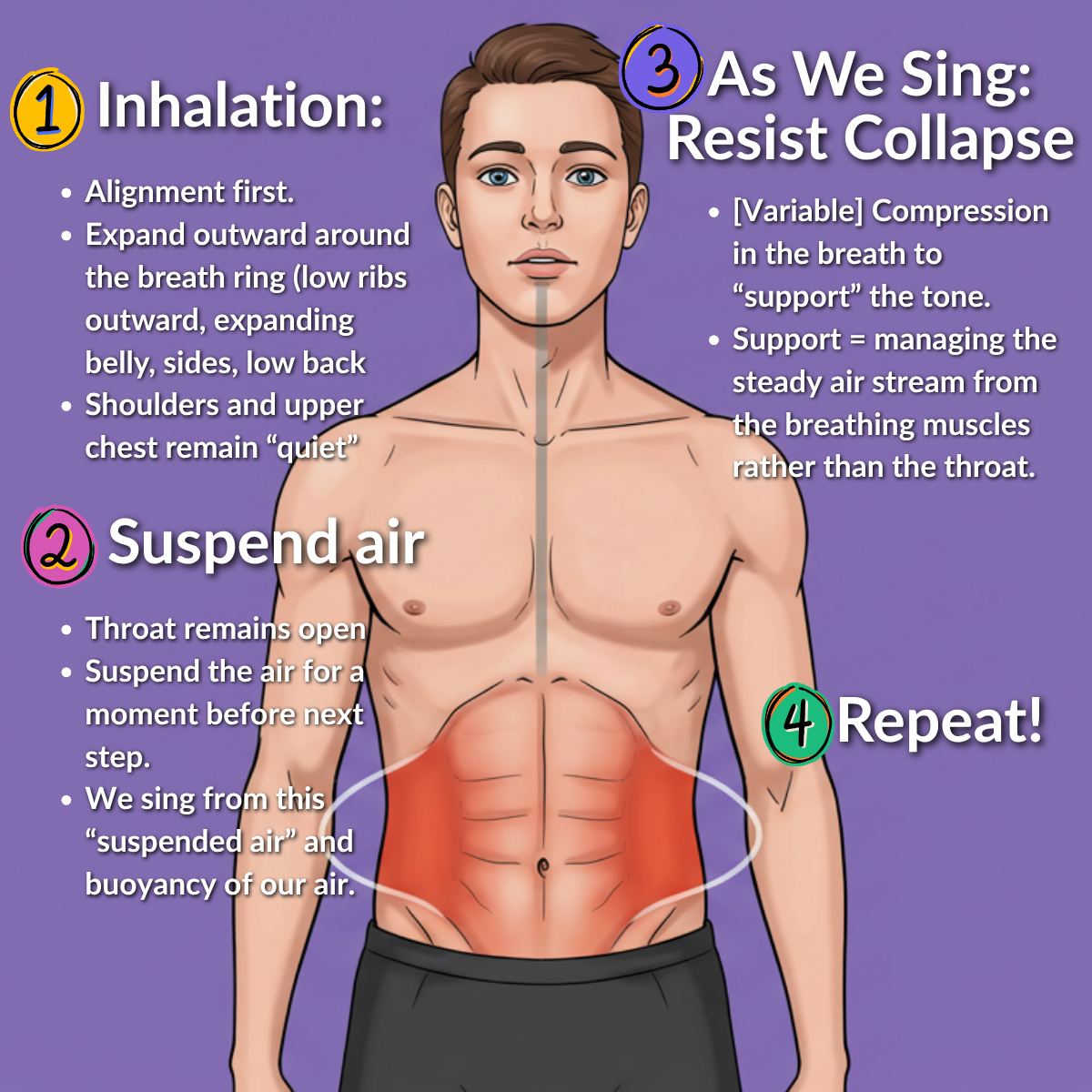🎤 What Is Breath Support, Really? Understanding Compression Without the Confusion
You’ve probably heard it a thousand times:
“Use more support!”
“Sing from the diaphragm!”
“Don’t push, but don’t be breathy either!”
Sound familiar?
Most singers know they’re supposed to have good breath support…
But very few actually know what that means—especially when it comes to compression, the unsung hero of healthy, powerful singing.
So let’s clear this up. Once and for all.
💡 First: What Is Compression?
Compression is the muscular coordination that allows you to manage the air pressure underneath your vocal folds (called subglottic pressure) as you sing.
It’s not about “holding your breath.”
It’s not about pushing out tons of air.
And it’s definitely not about squeezing your abs until your voice sounds like you’re doing crunches.
Instead, compression is a delicate balancing act:
You’re resisting the collapse of your body’s breathing structures just enough to create a steady, efficient flow of air through the vocal folds.
That steady flow is what powers clean tone, strong resonance, and expressive dynamics.
🧠 So… Why Is Compression So Important?
Because singing is a pressure game.
Your vocal folds need enough pressure to vibrate freely—but not so much that they slam together, and not so little that they flop around.
Here’s what can go wrong without healthy compression:
| 🫥 Too Little Compression | 😤 Too Much Compression |
|---|---|
| Breathiness | Harsh, tense tone |
| Weak onset | Strained onset |
| Collapsed ribs | Raised shoulders |
| Short phrases | Choppy airflow |
| No dynamic control | Fatigue or hoarseness |
The sweet spot?
You want the minimum effort for maximum tone. That’s the magic zone of healthy compression.
🎯 But What Is It Supposed to Feel Like?
Great question. Because here’s the truth:
You can’t see compression.
You won’t hear it directly.
You must learn to feel it.
Here’s a sensory way to start experiencing it:
🔹 Try this:
- Take a low, relaxed breath—let your belly and ribs gently expand.
- Purse your lips and slowly blow out like you’re trying to move a candle flame without blowing it out.
- Notice:
- Your abs naturally firm up
- Your rib cage stays wide
- The flow of air is steady—not forced
🎯 That subtle, active control you feel?
That’s the beginning of compression.
It’s not “holding” the breath.
It’s managing it—from below the voice, with just the right amount of internal resistance.
🧪 Compression Builders You Can Practice Today
Let’s walk through a few entry-level exercises that train your body to understand and build healthy compression.
1️⃣ The Steady Hiss
This is like weight training for your breath system.
How to do it:
- Take a low, quiet breath in.
- On a steady hiss (“ssssss”), time yourself:
- Can you go for 20 seconds?
- Can you increase to 30+ seconds?
- Keep the hiss even—no sputtering, no fading.
Feel for:
- Slight abdominal tension growing over time
- Rib cage staying expanded (no collapse!)
2️⃣ Pulsed Hisses
This teaches you how to release air in bursts, which builds control over onset and phrasing.
How to do it:
- Hiss for a few seconds… stop.
- Inhale quickly (reflex breath)… hiss again.
- Repeat 6–10 pulses, always keeping the torso stable.
3️⃣ Straw Phonation
This is a favorite among voice pros—it uses back pressure to help the vocal folds stay efficient without effort.
How to do it:
- Take a drinking straw.
- Hum through it on a single pitch, like “ooooo.”
- Do sirens (glides), scales, or simple songs.
Feel for:
- Airflow resistance (back pressure)
- Minimal throat effort
- Core engagement from low in the torso
4️⃣ Sing After the Trill
Use a lip trill or straw to prime the right balance—then go straight into singing.
How to do it:
- Trill a short phrase.
- Repeat that same phrase on “oo” or words right after.
Notice how your body wants to keep the efficient breath setup from the trill. That’s compression at work.
🚨 Warning: What Compression Is Not
As you experiment, be careful of these common traps:
| ❌ Mistake | 🛠 Fix |
|---|---|
| Clenching your abs | Try a hiss or straw hum—focus on control, not force |
| Holding your breath | Imagine the air flowing through the phrase, not behind it |
| Raising shoulders | Revisit low breathing and rib expansion—shoulders stay relaxed |
| Straining the throat | Use SOVT tools (straws, trills) to reset balance |
🧭 One Final Reminder:
Compression is a coordination—not a muscle.
It can’t be “forced into place.” It has to be discovered through:
- Sensation
- Exploration
- Feedback
Which is why, even with great articles like this, nothing replaces working with a skilled coach—someone who can listen, watch, and help you feel what’s working and what’s not.
🎶 Ready to Take It Further?
If you’ve ever thought:
“I know I can sing—but why doesn’t it always feel easy?”
Then this is your invitation to go deeper.
📍 At Ted’s Voice Academy, we work with singers just like you—people with passion and potential who are ready to build the vocal confidence and consistency they’ve always wanted.
🎤 One-on-one coaching
🎧 Custom exercises and practice plans
🎯 Breakthroughs in tone, range, and freedom
👉 Schedule a session today or explore our Flagship Vocal Confidence Series to start experiencing real progress—backed by science and shaped by artistry.






Leave a Reply